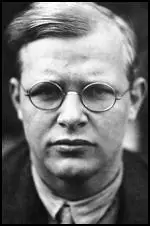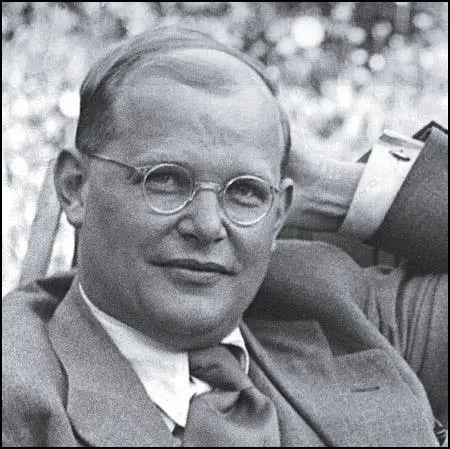Dietrich Bonhoeffer

Dietrich Bonhoeffer, the son of the psychiatrist Karl Bonhoeffer, and brother of Klaus Bonhoeffer, was born Breslau, Germany, on 4th February, 1906. He went to the Grunewald Gymnasium in Berlin where he became friends with Hans Dohnányi. He studied theology in Tubingen and in 1927 published Sanctorum Communio. In 1930 he went to New York to study at the Union Theological Seminary.
On his return to Germany he published Act and Being (1931) and became a lecturer in theological. As he was a strong opponent of fascism he decided to leave Germany when Adolf Hitler gained power in 1933 and found work as a pastor in London.
When he heard that Martin Niemöller and Karl Barth had formed the anti-Nazi Confessional Church, Bonhoeffer decided to return and join the struggle. He wrote to Reinhold Niebuhr: "I must live through this difficult period of our national history with the Christian people of Germany…. Christians in Germany are going to face the terrible alternative of either willing the defeat of their nation in order that Christian civilization may survive, or willing the victory of their nation and thereby destroying our civilization. I know which of these alternatives I must choose."
Elisabeth Sifton and Fritz Stern have argued: "Seeing that the Nazis intended to impose their dogma - that race, not religion, determined one’s civic identity - on the churches, Bonhoeffer joined other pastors in challenging the conservative-reactionary church leaders who acceded to this view. The dissidents organized themselves into what became known as the Confessing Church, which more than two thousand pastors joined, and Bonhoeffer alerted ecumenical organizations abroad to the Nazi threats. In 1935, he readily accepted a teaching position at a remote Pomeranian estate in a quasi-legitimate “preachers’ seminary.” He spent three years there, but went often to Berlin to see his parents - and to talk to his brother-in-law Hans, who was fighting the Nazis on different fronts." By 1937 over 800 pastors had been arrested. Bonhoeffer was banned from public meetings in Berlin, but he continued to teach and guide his students in Pomerania.
In 1938 Hans Dohnányi introduced Bonhoeffer to Wilhelm Canaris, the head of Abwehr, and Hans Oster his Chief of Staff. Both men were involved in an anti-Nazi conspiracy. Bonhoeffer was recruited as a double agent. As Alan Bullock has pointed out: "The Abwehr provided admirable cover and unique facilities for a conspiracy." On 19th March, 1939, Canaris sent him to London to meet with Bishop George Bell. The next month he went on a mission to the United States. On a visit to Sweden in 1942, Bonhoeffer visited Sweden and passed on proposals from the conspirators for peace terms with the Allies. According to Louis L. Snyder: "He helped seven Jews to escape to Switzerland, an operation that nearly cost him his life... All those who came into contact with him were impressed by his noble bearing and cheerfulness under painful conditions."

In early 1943 a group of anti-Nazis that included Bonhoeffer, Wilhelm Canaris, Friedrich Olbricht, Henning von Tresckow, Friedrich Olbricht, Werner von Haeften, Claus von Stauffenberg, Fabian Schlabrendorff, Carl Goerdeler, Julius Leber, Ulrich Hassell, Hans Oster, Peter von Wartenburg, Hans Dohnányi, Erwin Rommel, Franz Halder, Klaus Bonhoeffer, Hans Gisevius, Fabian Schlabrendorff, Ludwig Beck and Erwin von Witzleben met to discuss what action they should take. Initially the group was divided over the issue of Hitler. Gisevius and a small group of predominantly younger conspirators felt that he should be killed immediately. Canaris, Witzleben, Beck, Rommel and most of the other conspirators believed that Hitler should be arrested and put on trial. By using the legal system to expose the crimes of the regime, they hoped to avoid making a martyr of Hitler. Oster and Dohnanyi argued that after Hitler was arrested he should be brought before a panel of physicians chaired by Dohnanyi's father-in-law, the psychiatrist Karl Bonhoeffer, and declared mentally ill.
On 5th April 1943, Schutzstaffel (SS) officers entered the Abwehr building in Berlin. Wilhelm Canaris was told that they had received information that Hans Dohnányi had been taking bribes for smuggling Jews into Switzerland. After carrying out a search of the premises Dohnányi was arrested. Later that day Dohnányi's wife and several of his friends, including Dietrich Bonhoeffer and Klaus Bonhoeffer, were also taken into custody. Dohnányi managed to send out a message to General Ludwig Beck asking him to destroy his records of the conspiracy. However, Beck insisted that they be preserved for historical evidence of what Good Germans had done to fight Nazism.
Dohnányi's archives were found by the Gestapo on 22nd January 1944. This led to the arrest of other conspirators, including Arthur Nebe. Although clearly guilty of treason, Dohnányi was kept alive in an attempt to discover the full extent of the conspiracy against Adolf Hitler. In June 1944 he smuggled out a message to Otto John: "Not one of us really knows how long he can resist torture once they start doing their worst." Dohnányi arranged for his wife to smuggle him a dysentery culture. This produced a grave case of the disease that provided periodic relief from the ordeal of interrogation.
Bonhoeffer was sent to Buchenwald Concentration Camp. On 4th April 1945 the Gestapo discovered the secret diaries of Wilhelm Canaris. Hitler now gave orders for the conspirators to be executed. This information was used in the trial of Bonhoeffer, Canaris, Hans Dohnányi, Hans Oster, Ludwig Gehre and Karl Sack. Oster appeared first and having abandoned hope, admitted everything. Canaris also confessed and the others followed. That evening the court pronounced the death sentence on all the men. That evening Canaris tapped out a final message to the prisoner in the next cell, a Danish secret service officer: "My days are done. Was not a traitor."
Dietrich Bonhoeffer was hanged at Sachsenhausen Concentration Camp on 9th April 1945. Elisabeth Sifton and Fritz Stern have suggested: "One truth we can affirm: Hitler had no greater, more courageous, and more admirable enemies than Hans von Dohnányi and Dietrich Bonhoeffer. Both men and those closest to them deserve to be remembered and honored. Dohnányi summed up their work and spirit with apt simplicity when he said that they were 'on the path that a decent person inevitably takes.' So few traveled that path - anywhere." Bonhoeffer's books, Ethics (1949) and Letters from Prison (1953) were published posthumously.
Primary Sources
(1) Joachim Fest, Plotting Hitler's Death (1997)
Another series of attempts to establish contact had been under way in Stockholm since the early 1940s and revolved largely around Theodor Steltzer, a key member of the Kreisau Circle. In May 1942 Bishop George Bell of Chichester met with Dietrich Bonhoeffer and his fellow clergyman Hans Schonfeld in Stockholm. Without knowing anything about the plans of the other, the two Germans had both decided to go to Sweden when they learned that Bell would be there. They told him about the opposition and the Kreisauers' ideas for peace and expressed the hope that some token of encouragement might be offered. Bell was quite well acquainted with Bonhoeffer, who had been a pastor in the German church in London during the 1930s, and knew that he was one of the leading figures in the Confessional Church in Germany. A man of radical religious conviction, Bonhoeffer had repeatedly insisted that Hitler had to be "exterminated" regardless of the political consequences. At a secret church conference in Geneva in 1941 he had gone even further, announcing that he prayed for the defeat of his country because that was the only way Germany would be able to atone for the crimes it had committed. Schonfeld, on the other hand, brought only one question: Would the Allies adopt a different stance toward a Germany that had liberated itself from Hitler than they would toward a Germany still under his rule? Bell forwarded a report to the British Foreign Office, but Anthony Eden wrote back only to say he was "satisfied that it is not in the national interest to provide an answer of any kind." When Bell approached the British Foreign Office again, Eden noted in the margin of his reply, "I see no reason whatsoever to encourage this pestilent priest!"
(2) Elisabeth Sifton and Fritz Stern, New York Review of Books (25th October, 2012)
Seeing that the Nazis intended to impose their dogma - that race, not religion, determined one’s civic identity - on the churches, Bonhoeffer joined other pastors in challenging the conservative-reactionary church leaders who acceded to this view. The dissidents organized themselves into what became known as the Confessing Church, which more than two thousand pastors joined, and Bonhoeffer alerted ecumenical organizations abroad to the Nazi threats. In 1935, he readily accepted a teaching position at a remote Pomeranian estate in a quasi-legitimate “preachers’ seminary.” He spent three years there, but went often to Berlin to see his parents - and to talk to his brother-in-law Hans, who was fighting the Nazis on different fronts.
